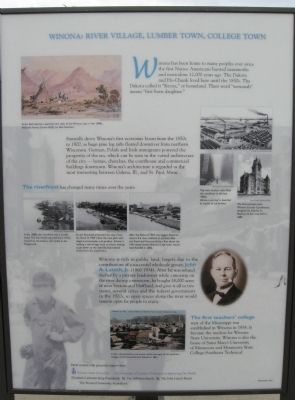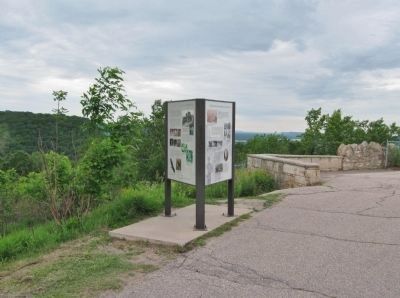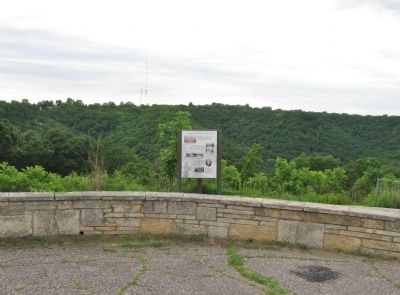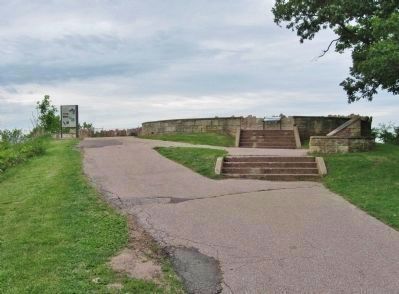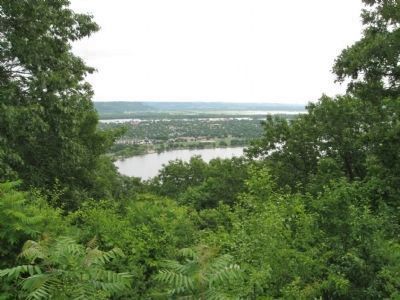Winona in Winona County, Minnesota — The American Midwest (Upper Plains)
Winona: River Village, Lumber Town, College Town
Inscription.
Winona has been home to many peoples ever since the first Native Americans hunted mammoths and mastodons 12,000 years ago. The Dakota and Ho-Chunk lived here until the 1850s. The Dakota called it "Keoxa," or homeland. Their word "wenonah" means "first-born daughter."
Sawmills drove Winona's first economic boom from the 1850s to 1900, as huge pine log rafts floated downriver from northern Wisconsin. German, Polish and Irish immigrants powered the prosperity of the era, which can be seen in the varied architecture of the city — homes, churches, the courthouse and commercial buildings downtown. Winona's architecture is regarded as the most interesting between Galena, Ill., and St. Paul, Minn.
Winona is rich in public land, largely due to the contributions of a successful wholesale grocer, John A. Latsch, Jr. (1860-1934). After he was refused shelter by a private landowner while canoeing on the river during a rainstorm, he bought 18,000 acres of river bottom and bluffland, and gave it all to two states, several cities and the federal government in the 1920s, so open spaces along the river would remain open for people to enjoy.
The first teachers' college west of the Mississippi was established in Winona in 1858. It became the nucleus for Winona State University. Winona is also the home of Saint Mary's University of Minnesota and Minnesota State College-Southeast Technical.
Panel created with generous support from: Winona State University — A Community of Learners Dedicated to Improving Our World · Elizabeth Callender King Foundation · The Jefferson Family · The John Latsch Board · The Winona Community Foundation.
Topics. This historical marker is listed in these topic lists: Charity & Public Work • Education • Native Americans • Settlements & Settlers. A significant historical year for this entry is 1900.
Location. 44° 2.075′ N, 91° 39.093′ W. Marker is in Winona, Minnesota, in Winona County. Marker can be reached from High Road, 0.2 miles north of East Garvin Heights Road. Marker is at the Garvin Heights Overlook in Garvin Heights Park. Touch for map. Marker is in this post office area: Winona MN 55987, United States of America. Touch for directions.
Other nearby markers. At least 8 other markers are within 2 miles of this marker, measured as the crow flies. Garvin Heights (a few steps from this marker); Stephen Taylor (approx. 0.3 miles away); Potters' Field (approx. 0.4 miles away); U.S. Coast Guard Cutter Winona (approx. 0.6 miles away); Sugar Loaf Bluff (approx. 1.2 miles away); The Watkins Manor House
(approx. 1.2 miles away); We-No-Nah (approx. 1.2 miles away); Winona County Soldiers and Sailors Memorial (approx. 1.3 miles away). Touch for a list and map of all markers in Winona.
More about this marker. sketch and photo captions, top to bottom:
• Artist Seth Eastman sketched this view of the Winona area in the 1840s. Wabasha Prairie, Curious Bluffs, by Seth Eastman. Minnesota State Historical Society
• Top, busy lumber mills filled the riverfront in the late 1800s. Winona County Historical Society
• Above, a worker is dwarfed by stacks of cut lumber. Winona County Historical Society
• The Romanesque-style Winona County Courthouse, designed by Charles G. Maybury & Son, was built in 1889. Winona County Historical Society
The riverfront has changed many times over the years.
• In the 1880s, the riverfront was a muddy shore. The last remaining prehistoric Indian mound on the levee is still visible in the foreground. Winona County Historical Society
• A new floodwall protected the town from the flood of 1902. Note the new park with
elegant promenades and gardens. A boat is holding a raft of logs close to shore, waiting to go down to the sawmills that extend inland from the waterfront. Winona County Historical Society
• After the flood of 1965, the biggest flood on record, the town created an earthen dike and flood wall that stands four feet above the 1965 water levels. Without it the town would have flooded in 2002. Pamela Eyden
• In this old postcard, a red arrow marks the spot of the teachers' college, the Winona Normal School, in 1861. Winona State University
Also see . . .
1. Winona, Minnesota. Wikipedia entry. "The Germans and the Yankee's worked together planting trees and building businesses based on lumber, wheat, steamboating and railroads. Together, they were so successful that for a time Winona had more millionaires than any other city of its size in the United States." (Submitted on January 3, 2015.)
2. Winona County History. "The Mississippi River forms its eastern boundary. The bluffs along its course reach a greater height in this county than in any other county along its course.... The western portion consists of very rolling prairies, interspersed with ravines and valleys." (Submitted on January 3, 2015.)
3. Latsch was an eccentric of the time, and a successful one
. Winona Daily News. "Latsch was so upset by the incident that the next morning he directed his business agent to buy up the land he’d been booted off of the day before. He immediately donated it to the state of Minnesota as a public park..." (Submitted on January 3, 2015.)
4. When lumber was king. Winona Daily News. "At first thought, a city with only one tree is an unlikely site for a sawmill. But on second thought... a town without trees needs lumber..." (Submitted on January 3, 2015.)
5. Winona State University. Wikipedia entry. History. "Classes began in 1860, although the school closed for nearly three years during the Civil War. It reopened in November, 1864 to continue its mission of preparing teachers for the new State of Minnesota." (Submitted on January 3, 2015.)
Credits. This page was last revised on June 16, 2016. It was originally submitted on January 3, 2015, by Keith L of Wisconsin Rapids, Wisconsin. This page has been viewed 581 times since then and 32 times this year. Photos: 1, 2, 3, 4, 5. submitted on January 3, 2015, by Keith L of Wisconsin Rapids, Wisconsin.
